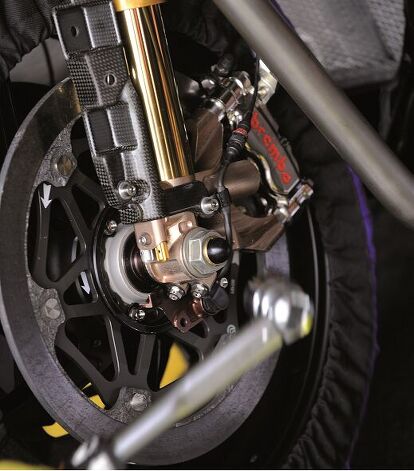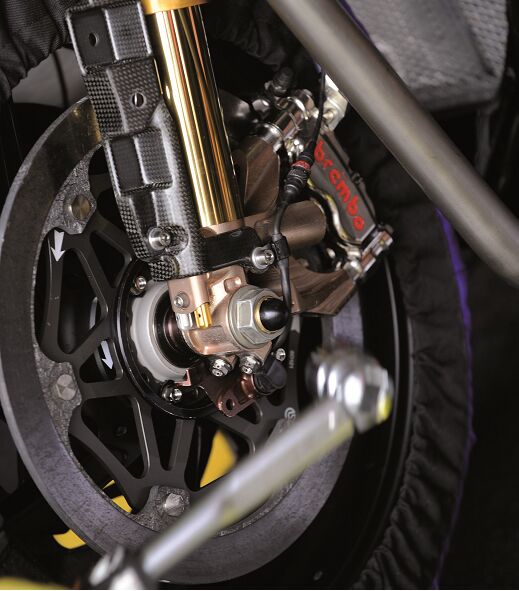Brembo Explains Why MotoGP Bikes Use 340mm Discs

Since MotoGP is the cutting edge of motorcycle technology, even with the new restrictions aimed at cost reduction, any time we can get a glimpse into the rarefied world of making motorcycles go – and stop – faster is an opportunity to be savored. In first part of Brembo’s Secrets of Braking in MotoGP series, we learn the reasoning behind the move to 340 mm discs on MotoGP bikes. We hope you find it as fascinating as we did.
Begin Press Release:
WHY DO THE MOTOGP BIKES USE 340 MM BRAKE DISCS?
Brembo tells you the whole truth
MotoGP is the most intense field of research in the world of motorbikes: even if Dorna’s rules are conceived to reduce costs, research does not stop and performance increases despite the new limits that are constantly being imposed. The Brembo technicians who supply discs and calipers to virtually all the teams involved in the world MotoGP top class know all about this. Lorenzo Bortolozzo, Brembo MotoGP Customer Manager, has answered some questions that are useful for understanding the impact of braking systems on the performance of 1000cc prototypes.
“In recent years the rules have imposed very heavy motorcycles that are however capable of increasingly high speeds and this has meant that we had to update our carbon braking system”.
What needed to be done?
“When braking, motorcycles generate kinetic energy that must be dissipated through the heat that is generated by friction between the carbon disc and the pad which is also made of carbon.
Up to three years ago, discs could be used with a maximum diameter of 320 mm, but as the speed and weight of motorbikes increased, we went very close to the performance and safety limit for this type of disc.
Carbon works very well at high temperatures but when certain limits are exceeded, especially several times on the same lap, oxidation becomes an issue.
Performance is reduced even if not dramatically, whereas disc and pad wear increases rapidly causing problems for safety. The rider notices a slight drop in performance, but this is accompanied by a significant increase in wear which can lead to… the pad coming off the caliper!”
What steps did you take?
“When we could not increase the disc’s diameter because of the limits imposed by Dorna and IRTA, we increased the friction surface of the pad to facilitate heat dissipation. But we then reached a point when that was not enough either…”
Did you raise a safety concern with the MotoGP organisers?
“Dorna and IRTA were very sensitive to the problem since we were very close to the material’s performance/safety limit and from 2014 onwards, we have been allowed to use a larger disc with a 340 mm diameter that has the same thickness to avoid having to change the calipers as well. In addition to safety and performance, they also considered costs to avoid an escalation in price.”
Was the 340 mm diameter disc a solution?
“Many teams have combined the large disc with calipers that have larger surface pads. With the 340 mm diameter disc, you can generate the same braking torque as 320 mm discs. With 320 mm discs, the riders, as could clearly be seen in TV footage, came very close to overturning their bikes and the rear wheel came off the ground when braking.
Although it produced the same braking torque, the modification did however bring about significant changes: pressure during braking decreased and braking times became shorter with a subsequent reduction in disc and pad temperature.”
“Yes, but it amounts to 100 grams or so, that is to say, a value that the rider does not notice when handling the bike since a disc weighs just over 1.3 kg, whereas a wheel with tyre weighs a lot more (almost one order of magnitude more).”
What was the difference in temperature between the discs?
“There was a difference of approximately 100 degrees between the 320 mm and 340 mm discs! If we consider that peak temperature reaches approximately 800 degrees, it is clear that the intervention was very important in improving rider safety.”
In 2015 did we see a multitude of air vents for brakes?
“Yes we did, but they are for the calipers and not the discs.”
In F1 the braking system is also used to warm the tyres as well as for aerodynamic purposes: is this the same in MotoGP?
“No, our only aim is to improve braking performance and guarantee safety.”
[Source: Brembo.com]

Like most of the best happenings in his life, Evans stumbled into his motojournalism career. While on his way to a planned life in academia, he applied for a job at a motorcycle magazine, thinking he’d get the opportunity to write some freelance articles. Instead, he was offered a full-time job in which he discovered he could actually get paid to ride other people’s motorcycles – and he’s never looked back. Over the 25 years he’s been in the motorcycle industry, Evans has written two books, 101 Sportbike Performance Projects and How to Modify Your Metric Cruiser, and has ridden just about every production motorcycle manufactured. Evans has a deep love of motorcycles and believes they are a force for good in the world.
More by Evans Brasfield



































Comments
Join the conversation
"we increased the friction surface of the pad to facilitate heat dissipation." Probably not significant. Increasing the surface of the pad increases the friction proportionally. Heat follows friction, so heat increases proportionally. Bigger pads improve braking (you need less pressure for the same effect), and pad longevity, not so much heat dissipation. Bigger disks improve heat dissipation, that I can believe.
Evans is on fire at the moment. Every article is spot-on, Keep up the good work. These technical articles are only enlivened by good writing , showing great skill.